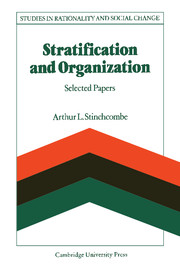Book contents
- Frontmatter
- Contents
- Acknowledgments
- 1 Rationality and social structure: an introduction
- PART I STRATIFICATION
- PART II ORGANIZATIONS
- 9 Bureaucratic and craft administration of production: a comparative study
- 10 Social structure and the founding of organizations
- 11 On social factors in administrative organization
- 12 Norms of exchange
- PART III SOCIOLOGY AS A PROFESSION
- Bibliography
- Name and place-name index
- Subject index
9 - Bureaucratic and craft administration of production: a comparative study
from PART II - ORGANIZATIONS
Published online by Cambridge University Press: 06 July 2010
- Frontmatter
- Contents
- Acknowledgments
- 1 Rationality and social structure: an introduction
- PART I STRATIFICATION
- PART II ORGANIZATIONS
- 9 Bureaucratic and craft administration of production: a comparative study
- 10 Social structure and the founding of organizations
- 11 On social factors in administrative organization
- 12 Norms of exchange
- PART III SOCIOLOGY AS A PROFESSION
- Bibliography
- Name and place-name index
- Subject index
Summary
Administration in the construction industry depends upon a highly professionalized manual labor force. The thesis of this paper is that the professionalization of the labor force in the construction industry serves the same functions as bureaucratic administration in mass production industries and is more rational than bureaucratic administration in the face of economic and technical constraints on construction projects.
Specifically we maintain that the main alternative to professional socialization of workers is communicating work decisions and standards through an administrative apparatus. But such an apparatus requires stable and finely adjusted communications channels. It is dependent on the continuous functioning of administrators in official statuses. Such continuous functioning is uneconomical in construction work because of the instability in the volume and product mix and of the geographical distribution of the work. Consequently the control of pace, manual skill, and effective operative decision (the essential components of industrial discipline) is more economical if left to professionally maintained occupational standards.
After presenting evidence and argument for these assertions, we will try to show why work on large-scale tract construction of houses continues to be administered on a nonbureaucratic, craft basis. Tract housing turns out to be a major revision in the marketing of construction products, rather than a revision in the administration of work.
Our method will be to reanalyze certain published demographic and economic data for their administrative implications. Since the data were collected for other purposes, they fit the requirements of our problem only roughly.
- Type
- Chapter
- Information
- Stratification and OrganizationSelected Papers, pp. 177 - 195Publisher: Cambridge University PressPrint publication year: 1986



